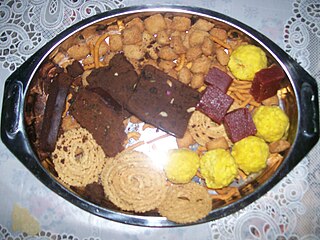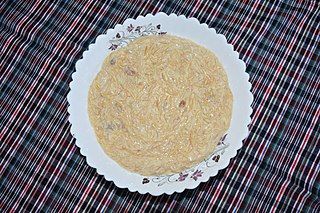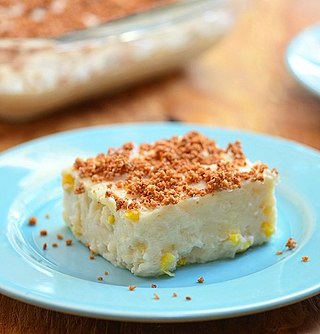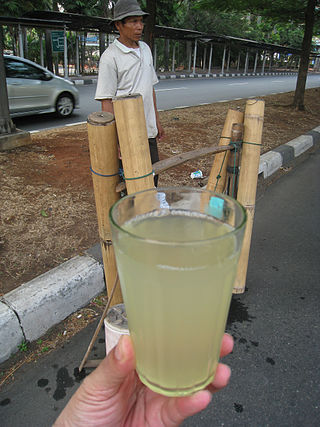This article needs additional citations for verification .(December 2024) |
Dodol Cover | |
|---|---|
Commune and village | |
| Country | |
| Time zone | UTC±00:00 (GMT) |
Dodol Cover is a village and rural commune in Mauritania. [1]
This article needs additional citations for verification .(December 2024) |
Dodol Cover | |
|---|---|
Commune and village | |
| Country | |
| Time zone | UTC±00:00 (GMT) |
Dodol Cover is a village and rural commune in Mauritania. [1]

Sri Lankan cuisine is known for its particular combinations of herbs, spices, fish, vegetables, rices, and fruits. The cuisine is highly centered around many varieties of rice, as well as coconut which is a ubiquitous plant throughout the country. Seafood also plays a significant role in the cuisine, be it fresh fish or preserved fish. As a country that was a hub in the historic oceanic silk road, contact with foreign traders brought new food items and cultural influences in addition to the local traditions of the country's ethnic groups, all of which have helped shape Sri Lankan cuisine. Influences from Indian, Indonesian and Dutch cuisines are most evident with Sri Lankan cuisine sharing close ties to other neighbouring South and Southeast Asian cuisines.

Nian gao, sometimes translated as year cake or New Year cake or Chinese New Year's cake, is a food prepared from glutinous rice flour and consumed in Chinese cuisine. It is also simply known as "rice cake". While it can be eaten all year round, traditionally it is most popular during the Chinese New Year. It is considered good luck to eat nian gao during this time of the year because nian gao (年糕) is a homonym for "higher year" or "grow every year" (年高), which means "a more prosperous year". The character 年 is literally translated as "year", and the character 糕 (gāo) is literally translated as "cake" and is identical in sound to the character 高, meaning "tall" or "high". In Mandarin, Nian gao (年糕) also is an exact homonym of "sticky cake" (黏糕/粘糕), the character 黏/粘 (nián) meaning "sticky".

Kue are bite-sized snacks or desserts originally from what is now Indonesia but have since spread throughout Southeast Asia. Kue is a fairly broad term in Indonesian to describe a wide variety of snacks including cakes, cookies, fritters, pies, scones, and patisserie. Kue are made from a variety of ingredients in various forms; some are steamed, fried or baked. They are popular snacks in Indonesia, which has the largest variety of kue. Because of the countries' historical colonial ties, Koeé (kue) is also popular in the Netherlands.

Garut is a district and town in West Java of Indonesia, and the former capital of Garut Regency. It is located about 75 km to the southeast of the major city of Bandung.

Sikhoraphum is a district (amphoe) in the central part of Surin province, northeastern Thailand.

Kalamay is a sticky sweet delicacy that is popular in many regions of the Philippines. It is made of coconut milk, brown sugar, and ground glutinous rice. It can also be flavored with margarine, peanut butter, or vanilla. Kalamay can be eaten alone, but is usually used as a sweetener for a number of Filipino desserts and beverages. It is related to the Chamorro dessert called kalamai.

Kuswar or Kuswad is a set of festive sweets and snacks made and exchanged by Christians of the Konkan region in the Indian subcontinent for the Christmas season or Christmastide. These goodies are major parts of the cuisines of the Goan Catholic community of Goa in the Konkan region, and the Mangalorean Catholic community of Karnataka. There are as many as 22 different ethnic recipes that form this distinct flavour of Christmas celebration in Goa and Mangalore. Kuswad is also made and exchanged by Karwari Catholics of Carnataca and the Kudali Catholics of Sindhudurg, in the Konkan division of Maharashtra.

Both festivals of Eid celebrated in the Muslim world include cuisines specific to countries and localities.

Maja blanca is a Filipino dessert with a gelatin-like consistency made primarily from coconut milk. Also known as coconut pudding, it is usually served during fiestas and during the holidays, especially Christmas.

Chen Fu Zhen Ren is an ancestral deity of the Indonesian Chinese people living throughout Banyuwangi Regency, Java, Bali, and Lombok. He is also worshipped by the indigenous population of Bali and Java (Kejawen).

Kalu dodol is a sweet dish, a type of dodol that is popular in Sri Lanka. The dark and sticky dish consists mainly of kithul jaggery, rice flour and coconut milk. Kalu dodol is a very difficult and time-consuming dish to prepare. The Hambanthota area is famous for the production of this dish.

Dodol is a sweet toffee-like sugar palm-based confection commonly found in Southeast Asia and the Indian subcontinent. Originating from the culinary traditions of Indonesia, it is also popular in Malaysia, Singapore, Brunei, the Philippines, Southern India, Sri Lanka, Thailand, and Burma, where it is called mont kalama. It is made from coconut milk, jaggery, and rice flour, and is sticky, thick, and sweet.

Lahang is a traditional sweet and cold beverage from West Java, Indonesia, made from the sap of Arenga pinnata. The drink is commonly known in Indonesia; however, it is usually associated with the Sundanese of West Java. It is known as a traditional isotonic drink.

Acehnese cuisine is the cuisine of the Acehnese people of Aceh in Sumatra, Indonesia. This cuisine is popular and widely known in Indonesia. Arab, Persian, and Indian traders influenced food culture in Aceh although flavours have substantially changed their original forms. The spices combined in Acehnese cuisine are commonly found in Indian and Arab cuisine, such as ginger, pepper, coriander, cumin, cloves, cinnamon, cardamom, and fennel.
Adi Kurdi was an Indonesian film and television actor known for his role as Abah in the television drama series, Keluarga Cemara, which aired from 1996 until 2005, with a series finale on TV7. His film credits included Aku Ingin Menciummu Sekali Saja (2002), Anak-Anak Borobudur (2007), and 3 Hari Untuk Selamanya (2007). Kurdi won the Maya Award for Best Actor in a Supporting Role for the film Catatan Dodol Calon Dokter in 2016

Madumongso or madumangsa is a Javanese snack made from black sticky rice as the main ingredient. The sweet flavour is a result of fermenting black sticky rice into tapai and then it is cooked to become dodol. Madumongso originates from Ponorogo, East Java.

Kue asida is an Indonesian pudding dessert made of water with mixture of wheat flour, sugar, cinnamon, cardamom, butter and honey. This dessert is typical Moluccan cuisine and also found in Malay Indonesian and Arab Indonesian cuisine. It usually served during Ramadan for iftar. Kue asida is similar to dodol.

Meuseukat is a dodol-like cake found in Acehnese cuisine. The cake is made using flour, sugar, a mixture of pineapple and lemon juice, and butter. The pineapple used in the cake imparts a yellow hue. Meuseukat is typically served on special occasions, such as during wedding festivities, and religious celebrations like Eid al-Fitr and Eid al-Adha.